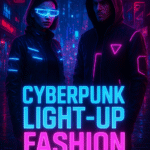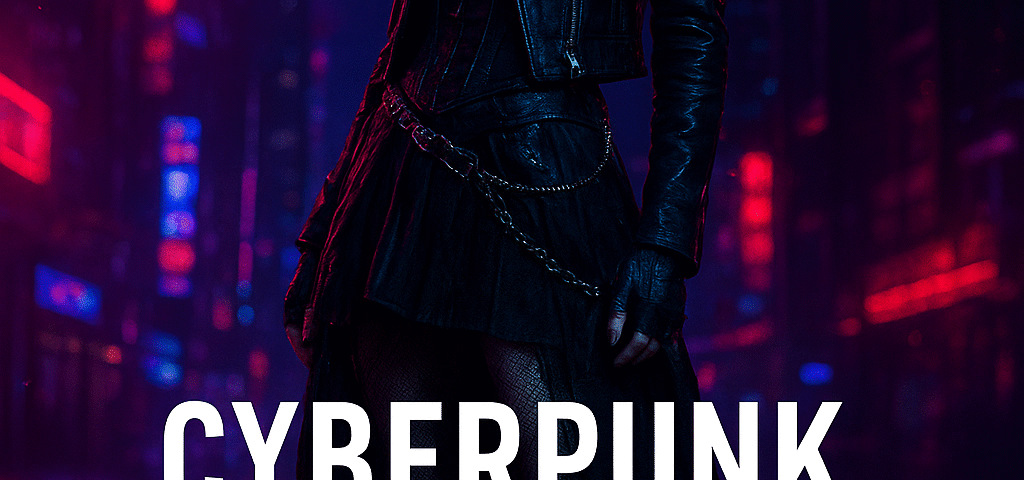
Tactical Cyberpunk Fashion: The Ultimate Guide to Futuristic Streetwear in 2025
October 22, 2025
Illuminating the Night: The Rise of Cyberpunk Light-Up Fashion
October 23, 2025In the ever-evolving landscape of creative genres, few combinations captivate the imagination quite like cyberpunk gothic fusion. This intriguing hybrid merges the neon-drenched, high-tech underbelly of cyberpunk with the shadowy, romantic allure of gothic aesthetics. Picture towering spires of ancient cathedrals illuminated by flickering holographic ads, or cybernetic enhancements cloaked in Victorian lace—it’s a world where the future collides with the macabre past. As digital realities blur with eternal mysteries, cyberpunk gothic fusion offers a fresh lens for storytelling, art, and even fashion. Whether you’re a writer, artist, or enthusiast, diving into this genre reveals endless possibilities for exploring themes of identity, decay, and rebellion in a hyper-connected society.
The Origins of Cyberpunk and Gothic Genres
To fully appreciate cyberpunk gothic fusion, it’s essential to understand the foundational genres it draws from. Cyberpunk emerged in the 1980s, pioneered by authors like William Gibson in his seminal novel Neuromancer. This genre paints a gritty future dominated by advanced technology, corporate overlords, and marginalized hackers navigating sprawling megacities. Themes of alienation, surveillance, and the human-machine interface dominate, often set against a backdrop of rain-slicked streets and glowing billboards.
On the other hand, the gothic genre has roots stretching back to the 18th century, with classics like Mary Shelley’s Frankenstein and Bram Stoker’s Dracula. Gothic tales thrive on atmosphere—haunted castles, forbidden desires, and supernatural elements that evoke fear, melancholy, and the sublime. It’s a realm of crumbling ruins, ethereal ghosts, and moral ambiguity, where the past haunts the present.
The fusion of these worlds isn’t entirely new; hints appeared in works like Ridley Scott’s Blade Runner (1982), which infused cyberpunk with gothic undertones through its brooding replicants and decaying urban landscapes. Today, cyberpunk gothic fusion evolves as creators seek to blend the mechanical precision of sci-fi with the emotional depth of gothic horror, creating narratives that feel both innovative and timeless.
How Cyberpunk and Gothic Elements Merge in Fusion
At its core, cyberpunk gothic fusion is about synergy. Cyberpunk’s fast-paced, tech-driven chaos meets gothic’s slow-burning dread, resulting in a genre that’s visually striking and thematically profound. Imagine a dystopian metropolis where gothic arches support sky-high data towers, or where vampires aren’t just bloodsuckers but AI-augmented immortals hacking into human consciousness.
This merger often explores shared motifs like isolation and transformation. In cyberpunk, characters grapple with cybernetic implants that erode their humanity; in gothic, it’s curses or elixirs that warp the soul. Fused together, these create stories of “cyber-ghosts”—digital specters haunting virtual realms—or “neon necromancers” who summon the dead through code. Semantic connections here include terms like “tech-noir romance” and “dystopian elegance,” which enhance the genre’s appeal in search engines by linking to broader cultural discussions.
Artists and writers leverage this fusion to critique modern society. For instance, the gothic emphasis on decay mirrors cyberpunk’s portrayal of environmental collapse, amplified by climate-ravaged worlds where ancient ruins are repurposed as hacker hideouts. This organic integration allows for rich world-building, where every element serves the narrative without feeling forced.
Key Elements Defining Cyberpunk Gothic Fusion
What makes cyberpunk gothic fusion stand out? Several core components define its aesthetic and thematic palette:
- Architecture and Setting: Envision gothic cathedrals retrofitted with holographic gargoyles or abandoned mansions turned into underground server farms. The contrast between ornate stonework and sleek chrome creates a visually arresting environment, symbolizing the clash between tradition and progress.
- Characters and Archetypes: Protagonists might be cybernetic outcasts with a gothic flair—think a hacker with tattooed runes that interface with ancient spells, or a corporate overlord resembling a Victorian villain with neural implants. Antagonists could be immortal AIs embodying gothic monsters, like digital werewolves prowling the net.
- Technology with a Dark Twist: Cyberpunk’s gadgets gain gothic mystique. Neural links become portals to haunted memories, and augmented reality overlays reveal spectral visions. This fusion often incorporates semantic keywords like “biohacked eternity” to evoke immortality through tech.
- Themes of Decay and Rebellion: Central to both genres, these amplify in fusion. Societal breakdown is depicted through crumbling infrastructures invaded by vines and viruses alike, while rebellion takes forms like underground cults merging code with occult rituals.
- Visual and Auditory Aesthetics: Neon purples and blacks dominate, with soundscapes blending synthwave beats and eerie organ music. This multisensory approach makes cyberpunk gothic fusion ideal for immersive media like VR experiences.
By incorporating these elements organically, creators ensure their works resonate with audiences seeking depth beyond surface-level sci-fi.
Examples in Literature, Film, Games, and Beyond
Cyberpunk gothic fusion has permeated various media, offering inspiring case studies. In literature, China Miéville’s Perdido Street Station hints at this blend with its steampunk-gothic world infused with bizarre tech. More directly, Jeff VanderMeer’s Borne fuses biotech horrors with dystopian ruins, embodying the genre’s essence.
Film enthusiasts will recognize it in The Matrix trilogy, where cyberpunk hacking meets gothic philosophy through its red-pill awakenings and shadowy agents. Guillermo del Toro’s Pan’s Labyrinth edges toward fusion with its fairy-tale gothic amid wartime tech, while Ghost in the Shell (1995) adds cybernetic souls to the mix.
In gaming, titles like Bloodborne by FromSoftware masterfully combine Lovecraftian gothic horror with mechanical combat in a decaying city. Cyberpunk 2077 itself nods to this with its Night City, where gothic-inspired gangs wield high-tech weaponry. Indie games like VA-11 Hall-A offer bartending sims in a cyberpunk bar with gothic undertones of personal hauntings.
Fashion also embraces cyberpunk gothic fusion. Designers like Rick Owens and Alexander McQueen inspire looks with leather corsets augmented by LED lights, or Victorian collars paired with circuit-board patterns. This style thrives on platforms like Instagram, where semantic tags like “neon victorian” drive visibility.
Fashion, Art, and Real-World Applications
Beyond entertainment, cyberpunk gothic fusion influences everyday creativity. In fashion, it’s about layering: fishnet stockings under holographic skirts, or boots with embedded screens displaying cryptic symbols. Brands like Demobaza and Cyberdog capitalize on this, blending gothic lace with cyberpunk metallics for outfits that scream rebellion.
Artists use this fusion in digital illustrations, where tools like Photoshop create scenes of rain-soaked alleys with ghostly holograms. For writers, incorporating it means building worlds with semantic richness—using phrases like “shadowy algorithms” to enhance SEO while deepening lore.
In real-world applications, architects draw inspiration for “neo-gothic skyscrapers” in cities like Tokyo, where traditional elements meet futuristic designs. Even in music, bands like The Birthday Massacre fuse gothic rock with electronic beats, creating soundtracks perfect for this genre.
Creating Your Own Cyberpunk Gothic Fusion Content
Ready to craft your own cyberpunk gothic fusion masterpiece? Start with research: Immerse in classics from both genres to identify fusion points. Outline your world—mix cyberpunk megacorps with gothic secret societies.
For writing, focus on descriptive language: “The cathedral’s stained-glass windows flickered with corrupted data streams, casting ethereal shadows on the hacker’s pale face.” Use tools like AI generators for initial ideas, but infuse personal twists.
In visual art, experiment with color palettes: deep crimsons against electric blues. Platforms like DeviantArt host communities for sharing and feedback.
Remember, semantic SEO thrives on natural integration—pepper your content with related terms like “futuristic macabre” to boost discoverability without keyword stuffing.
FAQs
What is cyberpunk gothic fusion?
Cyberpunk gothic fusion is a genre blend combining the high-tech, dystopian elements of cyberpunk with the dark, romantic, and supernatural vibes of gothic aesthetics. It creates worlds where neon lights illuminate ancient ruins and cybernetic beings grapple with eternal curses.
How does cyberpunk gothic fusion differ from traditional cyberpunk?
While traditional cyberpunk focuses on technology and societal decay, the fusion adds gothic layers like mysticism, ornate architecture, and emotional depth, making stories more atmospheric and introspective.
Can you give examples of cyberpunk gothic fusion in popular media?
Yes, games like Bloodborne and films like Blade Runner exemplify this. Literature such as Neuromancer with gothic twists also fits, alongside fashion lines merging Victorian styles with techwear.
Is cyberpunk gothic fusion suitable for beginners in writing?
Absolutely! Start with short stories blending familiar elements, like a hacker discovering a digital ghost. Resources like writing prompts online can help build confidence.
What future trends might we see in cyberpunk gothic fusion?
With AI and VR advancing, expect more immersive experiences, like interactive stories where users navigate fused worlds. Sustainability themes could merge gothic decay with cyberpunk eco-dystopias.
How can I incorporate cyberpunk gothic fusion into my wardrobe?
Opt for accessories like LED jewelry with antique designs or clothing with circuit patterns on velvet fabrics. Thrift stores and online shops like Etsy offer affordable starting points.
Why is semantic SEO important for content about cyberpunk gothic fusion?
It helps search engines understand context through related keywords, improving visibility for niche topics and connecting with enthusiasts searching for “neon horror” or similar terms.
Final Words
In conclusion, cyberpunk gothic fusion represents a thrilling evolution in creative expression, bridging the gap between tomorrow’s innovations and yesterday’s shadows. This genre not only entertains but provokes thought on our tech-saturated world, inviting us to question what it means to be human amid decay and digital eternity. Whether through stories, art, or style, embracing this fusion can spark endless inspiration. Dive in, experiment, and let your imagination run wild— the neon-lit spires await. If this resonates, share your creations and keep the conversation alive in the comments below.



